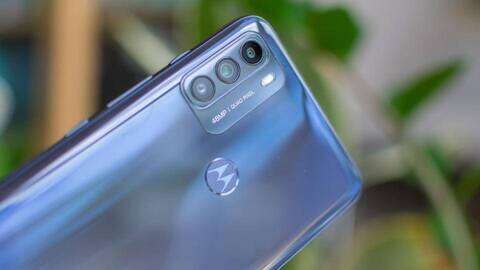Motorola Moto G50 review: Pick of the budget Moto Gs
Another day, another Moto. And there’s a certain (albeit uneven) logic to the Motorola Moto G50, coming as it does between the £450 Moto G100 , £160 G30 and £130 Moto G10 . But is the £200 Moto G50 pitched perfectly between the underpowered entry models and underwhelming premium version, or is it just an awkward middle child?


Motorola Moto G50 review: What you need to know
The Moto G family has swollen in ranks in recent years. Not content with just having a Play, Plus and Power variant of the G each year, Motorola has now gone into double and triple figures with its numbering system.

As I mentioned in my intro, the Moto G50 sits between the G10, G30 and G100 in terms of price, and that means you’re also getting (on paper) middle-child performance, although the G50 is certainly closer to the G30 than it is to the G100. You’re looking at an octa-core 2GHz Qualcomm Snapdragon 480 chipset backed up with 4GB of RAM and 64GB of built-in storage, with microSD expansion if required. There’s also a triple-camera array on the back, and it has a couple of nice-to-have features that are pretty rare at this price: a 90Hz screen and 5G connectivity.
Motorola Moto G50 review: Price and competition
Speaking of prices, the Moto G50 costs £200 , which makes it £70 more than the Moto G10 and £30 more than the Moto G30 . However, it’s a massive £250 cheaper than the Moto G100 . So, what else can you get around the £200 mark? Well, the best value proposition at the moment is the Xiaomi Poco X3 NFC , which also retails for £200 . The Moto G9 Plus costs that much these days , too, though it did originally retail for £260. Going a little cheaper, both the Realme 7 ( £180 ) and Xiaomi Redmi Note 9T (£229, but often much lower ) offer plenty of bang for your buck on a budget, too.
Motorola Moto G50 review: Design
Motorola handsets, from the cheapest to the most expensive (folding Razr aside), have all followed a pretty similar design trend in recent years, and the Moto G50 once again has looks that belie its cheap price of entry.
Motorola Moto G50 review: Screen
The Moto G50’s 6.5in screen is an IPS panel with a resolution of 1,600 x 720, which gives it a pixel density of 269ppi. That’s low for smartphones, but about what you expect from most laptop screens, which makes it more than sharp enough for most people’s needs.
Motorola Moto G50 review: Performance
The Motorola uses a Qualcomm Snapdragon 480 processor – a chipset we’ve only benchmarked once before when reviewing the middling £300 Nokia X20 . Suffice it to say at £100 cheaper, it’s easier to be complimentary about the Moto G50.
Crucially, when it comes to the 3D performance, it’s a huge improvement on the G10 and G30. Don’t be too drawn in by the eye-catching red line, though – that’s mainly because of the comparatively low-resolution 720p display. But even on the level playing field of the pale orange bar (where output is equalised to 1080p across the board) the Moto G50 goes toe-to-toe with all comers, only narrowly missing out to the marvellous Xiaomi Poco X3 NFC (note: we couldn’t get GFXBench working on the Redmi Note 9T, so it’s omitted here.)
And for battery life, probably helped again by the low-res screen, the Moto G50 is the new champion, managing a heroic 25hrs 45mins in our looped video test. That’s a couple of hours ahead of the other Motorola-branded competition, and seven hours ahead of the non Motos in our roundup. Really impressive.
Motorola Moto G50 review: Camera
As there now seems to be a law that all phones, no matter what price, must have at least three rear cameras, the Moto G50 duly follows suit, with three lenses of varying degrees of usefulness. The main 48MP (f/1.7) camera is joined by a 5MP (f/2.4) macro lens and a 2MP (f/2.4) depth sensor for arty bokeh shots.
Admittedly, it was an overcast day when I got my usual church shot in, but even with that allowance made, the image is a touch disappointing. It all looks okay(ish) from a distance…
...but zoom in, and you’ll see a worrying amount of noise especially around the windows. That doesn’t bode well for low-light conditions, but at sunset the Moto G50 coped reasonably well, all things considered. Here’s a shot of my garden as the sun began to recede.
It’s not too bad at all. You can clearly make out each distinct leaf, and while it’s not packed with detail, you certainly won’t struggle to figure out what you’re looking at.
Zoom into the frame and you’ll spot that the problems of day shots are greater in these low-light conditions. The image is even noisier, and any sense of detail is replaced with a blur as the camera sensor clearly struggles to cope. To be clear, this is a problem with all budget phone cameras, but the problem is less severe with either the Poco X3 NFC or Motorola’s last-gen Moto G9 Plus. You can do much better if you have an extra £150 to spend on the Google Pixel 4a , which has the same camera sensor and image processing credentials as the company’s top-end phones. The front-facing selfie camera is a 13MP (f/2.2) affair and images taken aren’t the most detailed I’ve seen, though it’s perfectly usable for selfies and video calls. Motorola offers a single beautification slider, which is sensibly disabled by default (left), but I’ve turned it up to halfway (middle) and all the way (right) to give you an idea of the general impact. It looks like it’s smoothing only, as the marks of my skin gradually get airbrushed out of existence.
As far as I can tell, video can only be captured at 1080p at 30fps – either that, or Motorola has hidden away the settings in a very hard-to-reach spot. Stabilisation is good, managing to stay pretty steady even when I was deliberately shaking the phone a lot, but the footage is a little soft and very light on detail.
Motorola Moto G50 review: Verdict
Slight camera disappointments aside, there’s a whole lot to recommend about the Moto G50. It looks great, has a decent screen, includes 5G support, has an incredible battery life and is only a hair behind the Poco X3 NFC in terms of performance for £200. Factor in the nice, clean installation of Android and it’s clear Motorola is on to a winner here.
All the same, the Moto G50 is probably my pick of the sub-£200 Motos, offering a great all-round package that’s hard to beat for the low cost of entry. And if 5G is vital to you, there’s really not much else at this price.
|
Motorola Moto G50 specifications |
|
Processor |
Octa-core Qualcomm Snapdragon 480 (2x2GHz, 6x18GHz) |
|
RAM |
4GB |
|
Screen size |
6.5in |
|
Screen resolution |
1,600 x 720 |
|
Pixel density |
269ppi |
|
Screen type |
IPS |
|
Screen refresh rate |
90Hz |
|
Front camera |
13MP (f/2.2) |
|
Rear camera |
48MP (f/1.7), 5MP (f/2.4) macro, 2MP (f/2.4) depth |
|
Flash |
LED |
|
Dust and water resistance |
No |
|
3.5mm headphone jack |
Yes |
|
Wireless charging |
No |
|
USB connection type |
USB-C |
|
Storage options |
64GB |
|
Memory card slot (supplied) |
microSD |
|
Wi-Fi |
802.11ac |
|
Bluetooth |
5 |
|
NFC |
Yes |
|
Cellular data |
5G, 4G |
|
Dual SIM |
Yes (shared with microSD) |
|
Dimensions (WDH) |
165 x 75 x 9mm |
|
Weight |
192g |
|
Operating system |
Android 11 |
|
Battery size |
5,000mAh |